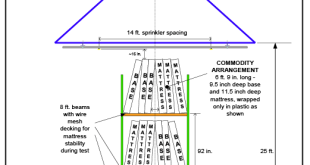CAN YOU MEET THE CHALLENGE?
In each issue, AFSA’s Engineering & Technical Services Department staff present technical challenges. Besides testing yourself and your co-workers, these exercises are excellent preparation for professional certification tests and may count as CEUs. Check with your certification organization. To participate, read through and work the problems. Answers to this issue’s questions will be presented in the next issue.
MAY/JUNE ANSWERS
The following questions are based on NFPA 14, 2019 edition.
1. What is the minimum clearance around standpipe valve handles outside of a cabinet?
A. 1 in.
B. 3 in.
C. 6 in.
D. 12 in.
NFPA 14-2019, Section 4.7.5, requires a minimum of 3 in. between a valve handle and any adjacent object when the valve is in any position from open to closed. This allows a firefighter to easily operate the valve while wearing gloves.
2. What is the minimum height for a standpipe hose connection per NFPA 14?
A. 12 in.
B. 18 in.
C. 24 in.
D. 36 in.
NFPA 14-2019, Section 7.3.1.1 requires that hose connections and hose stations be unobstructed and located 3 ft – 5 ft above the floor as measured from the floor to the center of the hose valve. This ensures that the hose connection is readily accessible for firefighter use without stooping or reaching.
3. When the maximum pressure in a new standpipe system is 180 psi, the system must be hydrostatically tested at?
A. 170 psi
B. 200 psi
C. 230 psi
D. 250 psi
Per NFPA 14-2019, Section 11.4.1, all new systems, including yard piping and fire department connection piping, must be hydrostatically tested for 2 hours at not less than 200 psi or 50 psi in excess of the system working pressure, whichever is greater. In this case, 180 psi + 50 psi = 230 psi.
4. Which of the following is true regarding the location of Class I standpipes?
A. Standpipes may be located in locked housekeeping closets to prevent tampering.
B. Standpipes must be located in hallways of public buildings.
C. Standpipes may be located anywhere in the building at the discretion of the installer.
D. Standpipes must be located in a fire-rated exit stairway or equivalent (where available).
Locating standpipes in fire-rated exit stairwells protects the piping and components from fire and mechanical damage. It also provides a safe space for firefighters to connect and charge hose lines before entering a fire area. See NFPA 14-2019, Section 6.1.2.2.1.
5. Assuming the building is fully sprinklered, the minimum flow capability for the hydraulically most remote standpipe for a Class I combined standpipe system is?
A. 500 gpm
B. 750 gpm
C. 1,000 gpm
D. 1,250 gpm
Sometimes the standard takes us on a bit of a hop, a skip, and a jump before we find the correct answer! This is a perfect example. NFPA 14-2019, Section 7.10.1.1.4 states that flow rates for combined systems must be in accordance with 7.10.1.3. So, skipping forward to that section, we see that 7.10.1.3.1 then states that for a building protected throughout by an approved automatic sprinkler system, the system demand established by Sections 7.7 and 7.10.1 are also permitted to serve the sprinkler system. Now jumping back to 7.10.1.1.1, we see that for Class I and Class III systems, the minimum flow rate for the hydraulically most remote standpipe is 500 gpm.
JULY/AUGUST QUESTIONS
The following questions are based on NFPA 25, Standard for the Inspection, Testing, and Maintenance of Water-Based Fire Protection Systems, 2023 edition.
1. True or False? NFPA 25 requires the inspector to verify the adequacy of the system design and installation.
2. Which of the following must be inspected every week?
A. Sprinklers
B. Reduced-pressure backflow assembly
C. Fire Department Connections
D. Waterflow alarm devices
3. Which of the following is true regarding sprinkler testing?
A. If one sprinkler within a sample fails to meet the test requirement, all sprinklers within the area represented by that sample must be replaced.
B. Sprinklers do not require testing unless they begin to lose fluid from the thermal element.
C. Dry sprinklers must be tested or replaced every 10 years.
D. All sprinkler types have the same testing requirements.
4. Which of the following locations would most likely require sprinkler testing/replacement every five years?
A. High-volume distribution warehouse
B. Cold storage warehouse
C. Saltwater marina
D. Patient care area in a hospital
5. How long must you operate the pump during a weekly diesel-driven pump churn test?
A. 10 minutes
B. 30 minutes
C. 60 minutes
D. 90 minutes
 Sprinkler Age A Publication of the American Fire Sprinkler Association
Sprinkler Age A Publication of the American Fire Sprinkler Association



